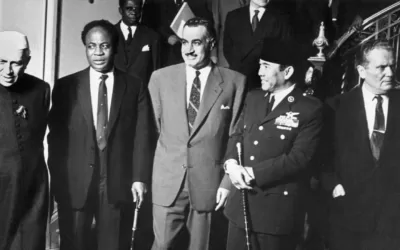Introduction
The Battle of Thermopylae, fought in 480 BC between the Greek city-states and the Persian Empire, is one of history’s most iconic and memorable conflicts. This battle, which took place in a narrow coastal passage in present-day Greece, is renowned for the incredible courage, tactical innovation, and leadership demonstrated by the Greeks in their stand against overwhelming Persian forces. In this article, we will explore the events leading up to the battle, the tactics employed by both sides, the outcome, and the lasting significance of Thermopylae in the annals of history.
I. The Prelude to Battle
1. The Persian Empire’s Expansion
The origins of the Battle of Thermopylae can be traced back to the Persian Empire’s rapid expansion under King Darius I and his successor, Xerxes I. The Persian Empire stretched from present-day Iran to the borders of Greece, and as its power grew, so did its ambitions. The empire sought to expand its influence across the Mediterranean and establish control over the Greek city-states.
2. The Ionian Revolt
In 499 BC, the Ionian Greek city-states, under Persian control, revolted against their overlords. The Athenians and Eretrians supported the Ionians in their struggle for independence, further provoking Persian ire. Although the revolt was ultimately crushed in 494 BC, it left a lasting impression on the Persian Empire, which sought retribution against the Greek city-states.
3. The First Persian Invasion
In response to the Ionian Revolt and the assistance provided by Athens and Eretria, Darius I launched the first Persian invasion of Greece in 492 BC. Although the Persians made significant advances, they were forced to withdraw after their fleet was destroyed in a storm. This setback did little to dampen Persian ambitions, and Xerxes I, Darius’ successor, began planning an even larger invasion.
II. The Battle Unfolds
1. Greek Strategy and Preparation
The Greek city-states, aware of the impending Persian invasion, formed an alliance known as the Hellenic League, led by Sparta and Athens. The allies decided to make a stand at the narrow coastal passage of Thermopylae, where the terrain would help neutralize the Persian advantage in numbers. King Leonidas I of Sparta was chosen to lead a force of 7,000 Greek hoplites.
2. The Persian Army
Xerxes’ forces were immense, with some estimates placing their numbers between 100,000 and 200,000 soldiers. This massive army, which included elite units such as the Immortals, marched towards Greece, crossing the Hellespont on a bridge of boats. As they advanced, the Persians faced little resistance until they reached Thermopylae.
3. The First Day of Battle
On the first day of the Battle of Thermopylae, Xerxes sent forward waves of infantry to test the Greek defenses. The Greeks, fighting in a tight phalanx formation, repelled each assault, using the narrow pass to their advantage. Persian casualties mounted rapidly, while the Greeks were able to rotate their troops to ensure they remained fresh for battle.
4. The Second Day of Battle
The second day of the battle unfolded much like the first, with the Greeks successfully holding their ground against Persian attacks. It was during this time that the Persians became aware of a mountain path known as the Anopaia, which bypassed the Greek defenses.
5. The Betrayal of Ephialtes
Ephialtes, a local resident seeking favor with the Persians, informed Xerxes of the Anopaia path. In response, Xerxes dispatched a force led by his elite Immortals to outflank the Greeks. Recognizing the danger, Leonidas sent a contingent of Phocians to defend the path, but they were ultimately defeated by the Persians.
6. The Third Day and the Last Stand
With the Persian forces moving to encircle them, Leonidas made the fateful decision to remain at Thermopylae with a small force of around 1,500 soldiers, including his 300 Spartans, to cover the retreat of the rest of the Greek army. This selfless act of sacrifice allowed the bulk of the Greek forces to withdraw safely and regroup for future battles.
As the Persians closed in, Leonidas and his remaining warriors fought to the last man, inflicting significant casualties on their enemies. Despite their valor, the Greeks were ultimately overwhelmed, and the Persians pushed forward into Greece.
III. The Aftermath and Significance of the Battle
1. The Impact on the Persian Invasion
Although the Persian forces had won the battle, the cost was high, and the delay at Thermopylae allowed the Greek city-states time to prepare for the continuing invasion. The Greek navy, led by the Athenians, achieved a decisive victory over the Persian fleet at the Battle of Salamis in 480 BC, forcing Xerxes to withdraw the majority of his forces from Greece. The following year, the Greeks scored another significant victory at the Battle of Plataea, effectively ending the Persian invasion.
2. The Legacy of Thermopylae
The Battle of Thermopylae has endured as a symbol of heroism, sacrifice, and the struggle for freedom against tyranny. The story of Leonidas and his 300 Spartans has been passed down through generations, inspiring countless retellings in literature, art, and film. Their bravery in the face of insurmountable odds became a rallying cry for future generations of Greeks and has resonated with people throughout history facing their own struggles against oppression.
3. The Influence on Greek Culture and Warfare
The Greek city-states emerged from the Persian Wars more united than ever before, and their successes against the mighty Persian Empire fostered a sense of cultural pride and self-confidence. This period of unity and the spirit of cooperation that followed contributed to the Golden Age of Athens, which saw unprecedented advancements in philosophy, art, and science.
In terms of warfare, the Battle of Thermopylae highlighted the importance of strategy and terrain in determining the outcome of battles. The Greeks’ use of the phalanx formation and their ability to maximize the advantages of their chosen battleground demonstrated that even smaller, well-disciplined forces could stand against numerically superior armies.
Conclusion
The Battle of Thermopylae remains one of history’s most iconic military engagements. The heroic stand of the Greek forces against the vast Persian army, led by King Leonidas and his 300 Spartans, has come to symbolize the indomitable human spirit in the face of overwhelming adversity. Although the Greeks were ultimately defeated at Thermopylae, their sacrifice bought precious time for their compatriots to rally and eventually repel the Persian invasion. The battle’s legacy has endured for centuries, inspiring countless retellings and cementing its place in the annals of history as a symbol of courage, sacrifice, and the fight for freedom. The Battle of Thermopylae demonstrated the importance of strategy, terrain, and discipline in warfare, and its impact on Greek culture and warfare cannot be overstated. The sense of unity and cooperation that emerged from the Greek city-states’ victory against the Persian Empire laid the foundation for a period of cultural and intellectual flourishing that has influenced human history for millennia. In conclusion, the Battle of Thermopylae is a testament to the enduring human spirit and the power of unity, sacrifice, and bravery in the face of seemingly insurmountable odds.
Keywords:
- Battle of Thermopylae: A historic battle fought in 480 BC between Greek city-states and the Persian Empire at a narrow coastal passage in present-day Greece.
- Persian Empire: A powerful empire that spanned from present-day Iran to the borders of Greece, seeking to expand its influence across the Mediterranean and establish control over the Greek city-states.
- Ionian Revolt: A revolt that occurred in 499 BC when the Ionian Greek city-states, under Persian control, rebelled against their overlords.
- Hellenic League: An alliance formed by Greek city-states, led by Sparta and Athens, to resist Persian invasion.
- Sparta: A Greek city-state that was a prominent military power and known for its discipline and strength.
- Athens: A Greek city-state known for its cultural and intellectual achievements.
- Xerxes I: A Persian king and successor of Darius I who led the second Persian invasion of Greece.
- Immortals: A group of elite Persian soldiers, considered to be the best of the Persian army.
- Phalanx formation: A tactical formation used by Greek hoplites, in which they formed a tight and compact block of soldiers armed with spears and shields.
- Anopaia: A mountain path that bypassed the Greek defenses at Thermopylae.
- Leonidas I: A Spartan king who led a force of 7,000 Greek hoplites at Thermopylae.
- Golden Age of Athens: A period of cultural and intellectual flourishing in Athens following the Persian Wars.
- Battle of Salamis: A naval battle in which the Greek navy, led by the Athenians, achieved a decisive victory over the Persian fleet in 480 BC.
- Battle of Plataea: A battle in which the Greeks scored a significant victory over the Persian forces in 479 BC, effectively ending the Persian invasion.
- Unity: The state of being united or working together towards a common goal, as demonstrated by the Greek city-states in their resistance against Persian invasion.












0 Comments